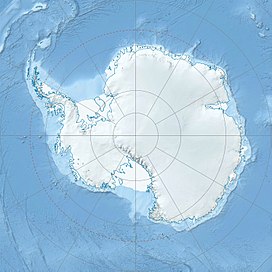Mount Foster is a peak rising to 2,025 metres (6,644 ft) in the Imeon Range on Smith Island in the South Shetland Islands of the British Antarctic Territory. It is the highest point of the South Shetland Islands archipelago. Mount Foster has triple peaks of which Mount Foster proper is the southernmost, the central one is Evlogi Peak (2,024 m), and the northern one is Antim Peak (1,995 m). The first ascent was made by Greg Landreth and his team comprising Brice Dowrick, Dan Mannix and Roger Thompson on 29-30 January 1996.[3][4]
| Mount Foster | |
|---|---|
 Left to right Mount Foster, Evlogi Peak and Antim Peak | |
| Highest point | |
| Elevation | 2,025 m (6,644 ft)[1] |
| Prominence | 2,025 m (6,644 ft)[1] |
| Listing | Ultra, Ribu |
| Coordinates | 62°59′42″S 62°33′06.3″W / 62.99500°S 62.551750°W[1] |
| Geography | |
Location in Antarctica | |
| Location | Smith Island, Antarctica |
| Range coordinates | 62°58′30″S 62°30′20″W / 62.97500°S 62.50556°W[2] |
| Parent range | Imeon Range |
| Climbing | |
| First ascent | Greg Landreth, Brice Dowrick, Dan Mannix and Roger Thompson, 1996 |
The feature is named after Captain Henry Foster, commander of HMS Chanticleer who explored the South Shetlands in 1829.[5]
Elevation
editTraditionally, the elevation of Mount Foster was put at 2,105 metres (6,906 ft).[6][7][4] However, according to the American high accuracy Reference Elevation Model of Antarctica (REMA) edition 2022, the actual elevation (at 2-meter spatial resolution) is 2,025 m, just 1 m higher than the adjacent Evlogi Peak.[2][1]
Location
editMount Foster is linked by Zavet Saddle (elevation 1,350 m) to Slaveykov Peak to the southwest and by a saddle of elevation 1,899 m to Evlogi Peak to the north-northeast. It surmounts Bistra Glacier to the west, Chuprene Glacier to the north-northwest, Rupite Glacier to the east, Landreth Glacier to the southeast and Dragoman Glacier to the south-southeast. The peak is located 5.45 km northeast of Riggs Peak, 2.78 km south-southeast of Garmen Point, 7.64 km southwest of Mount Pisgah and 3.86 km north-northwest of Ivan Asen Point (Bulgarian mapping in 2009).
Maps
edit- Chart of South Shetland including Coronation Island, &c. from the exploration of the sloop Dove in the years 1821 and 1822 by George Powell Commander of the same. Scale ca. 1:200000. London: Laurie, 1822
- L.L. Ivanov. Antarctica: Livingston Island and Greenwich, Robert, Snow and Smith Islands. Scale 1:120000 topographic map. Troyan: Manfred Wörner Foundation, 2010. ISBN 978-954-92032-9-5 (First edition 2009. ISBN 978-954-92032-6-4)
- South Shetland Islands: Smith and Low Islands. Scale 1:150000 topographic map No. 13677. British Antarctic Survey, 2009
- Antarctic Digital Database (ADD). Scale 1:250000 topographic map of Antarctica. Scientific Committee on Antarctic Research (SCAR). Since 1993, regularly upgraded and updated
- L.L. Ivanov. Antarctica: Livingston Island and Smith Island. Scale 1:100000 topographic map. Manfred Wörner Foundation, 2017. ISBN 978-619-90008-3-0
See also
editReferences
edit- ^ a b c d I.M. Howat, C. Porter, B.E. Smith, M.-J. Noh and P. Morin. Reference Elevation Model of Antarctica (REMA). Polar Geospatial Center. University of Minnesota, 2022 (Antarctic REMA Exlorer)
- ^ a b Bulgarian Antarctic Gazetteer
- ^ News from Antarctica: Mount Foster’s first ascent. Archived 2001-01-16 at the Wayback Machine
- ^ a b J. Stewart. Antarctica: An Encyclopedia. Jefferson, N.C. and London: McFarland, 2011. 1771 pp.
- ^ SCAR Composite Gazetteer of Antarctica: Mount Foster
- ^ "Antarctica Ultra-Prominences" Peaklist.org. Retrieved 2011-12-24
- ^ "Mount Foster, Antarctica" on Peakbagger
External links
edit- Mount Foster. Adjusted Copernix satellite image
